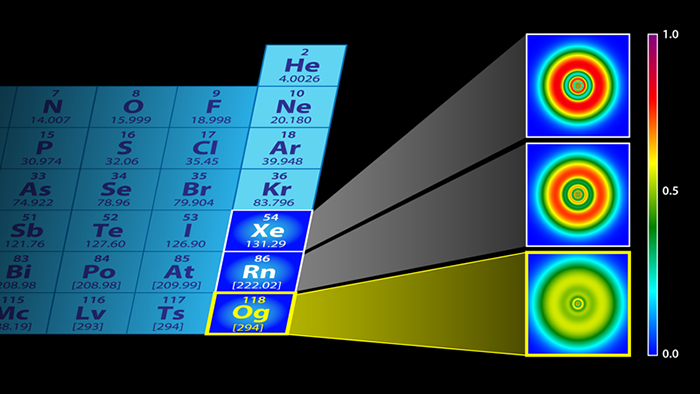What Is The Heaviest Atom
Oganesson (Og) is the heaviest element in the periodic tabular array, merely its properties accept proved difficult to mensurate since it was first synthesised in 2002.
Now an advanced reckoner simulation has filled in some of the gaps, and it turns out the element is even weirder than many expected.
At the atomic level, oganesson behaves remarkably differently to lighter elements in several central ways – and that could provide some central insights into the basics of how these superheavy elements piece of work.
The simulations run past the international team of scientists show that oganesson's electrons, protons, and neutrons don't follow the same rules equally the other noble gases that the element is grouped with, and that could have a big touch on on how we sympathise this section of the periodic table.
 Electronic structures of xenon (top), radon (middle), and oganesson (bottom). (P. Jerabek et al and APS/Alan Stonebraker)
Electronic structures of xenon (top), radon (middle), and oganesson (bottom). (P. Jerabek et al and APS/Alan Stonebraker)
"The superheavy elements represent the limit of nuclear mass and charge," says one of the researchers, Witek Nazarewicz from Michigan Country University. "They inhabit the remote corner of the nuclear landscape whose extent is unknown."
"The questions pertaining to superheavy systems are in the forefront of nuclear and atomic physics, and chemistry enquiry."
In lighter elements in the same element of group 0 family as oganesson, according to the Bohr model of the atom, electrons take up certain orbits or positions effectually the nucleus, forming beat out-similar groups around the eye.
Calculations known every bit fermion localisation functions are used to piece of work out where these electron shells are, but such are the big electrostatic forces produced past an oganesson cantlet, the rules of special relativity come into play.
With that in mind, the researchers used adapted fermion localisation functions called electron localisation functions to calculate where the electrons would be in oganesson. Turns out, the electron shells go almost duplicate, creating a kind of electron gas around the nucleus.
In other words, at the most primal level, it'due south non like other noble gases such as xenon or neon at all.
"On paper, we idea that it would have the same rare gas structure as the others in this family," says one of the researchers, Peter Schwerdtfeger from Massey University in New Zealand.
"In our calculations however, nosotros predict that oganesson more than or less loses its shell structure and becomes a smear of electrons."
That aforementioned smear or special gas land also applies to the neutrons inside the superheavy nucleus, according to the researchers' calculations, though the protons were shown to retain some kind of trounce-similar status.
We're talking some deep-level quantum physics here, but what it all means is that oganesson doesn't seem to be like the other elements it'south grouped with. The special blob formation of its electrons could mean it'south much more chemically reactive than the other noble gases, for example.
Some other possible consequence is that oganesson atoms would clump together in a solid at room temperature, rather than bouncing off one some other as they would unremarkably in a gas.
Now bear in mind these are simply computer simulations, admitting very complex ones – they aren't studies of oganesson itself. The element is besides hard to produce and lasts for such a brusque time that nosotros tin can't really examine it in the usual means.
Only now we have these predictions about the structure and properties of chemical element 118, scientists can put together experiments to try and put these hypotheses to the exam. That's the side by side stage in the inquiry.
Further downward the line, these insights could fifty-fifty assist the states work out how to produce an oganesson atom that lasts for more than a millisecond.
"Calculations are the but way to become at [oganesson's] behaviour with the tools that nosotros currently have, and they accept certainly provided some interesting findings," says Schwerdtfeger.
The inquiry has been published in Physical Review Letters.
What Is The Heaviest Atom,
Source: https://www.sciencealert.com/detailed-simulation-of-worlds-heaviest-oganesson-atom-show-its-weirdness
Posted by: scottaskins90.blogspot.com


0 Response to "What Is The Heaviest Atom"
Post a Comment